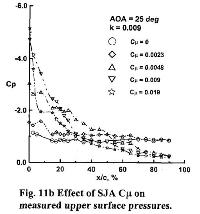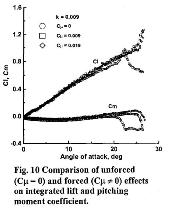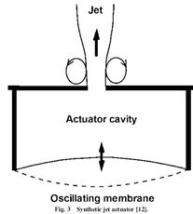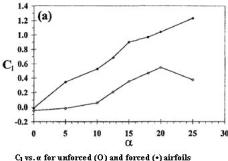![]() Active Flow Control with Synthetic Jet Actuators Applied to Flapping Wings
Active Flow Control with Synthetic Jet Actuators Applied to Flapping Wings
Executive Summary
 |
|
Unconventional tangential flow synthetic jet application |
Active flow control seeks to utilize smart materials to influence flow over a surface where less than desirable flow attributes are detected. Synthetic Jet Actuators (SJAs) are used to inject energy into weakened boundary layers by resonating a small vessel which re-energizes the immediate flow field.
Two different kinds of SJAs have been utilized on 2D symmetric airfoils to determine their effects on a lifting surface. Left is an unconventional jet application that introduces flow tangential to the lifting surface to directly energize the flow and mitigate local separation [Ref.1]. As shown in the graphs this technique extends the lift curve as the angle of attack increases, allowing an uncambered wing to continue flight past its post-stall angle of attack. Cµ is a non-dimensional constant that measures the amount of flow ejected from the jet. The graph below and on the left shows the radical effect that the tangential blowing jets have on the surface pressure. The circles represent no SJA activity and show the airfoils natural pressure curve. These jets are best used to mitigate flow separation when AOA is high or abruptly changing. Data to the right shows how this unconventional SJA can extend the lift curve to allow higher pitch angles and more lift for slow or fast climbing flight.
 |
 |
Momentum coefficient effect on upper surface pressures
|
Unforced and forced momentum coefficient effects |
 |
 |
Function of oscillating membrane |
Placement of a conventional SJA on an airfoil |
The data below corresponds to a more conventional approach to SJA usage (pictured above) where the flow is ejected perpendicular to the lifting surface [Ref.2]. Depending on the jet placement; this application is shown to improve performance both by mitigating separation and drastically increasing overall flow circulation. This approach works best for general flight where high pitch rates and unpredictable gusts are not as common.

Lift coefficient vs angle of attack for
unforced and forced airfoils
As seen above, much research has been conducted on the effects of a single SJA on a 2D airfoil. However, little has been done with 3D airfoils and optimizing a certain array of jets to mitigate specific aerodynamic weaknesses. This project seeks to investigate the effect of multiple SJAs in an array on airflow over a wing. Combining previous works on the effectiveness of single actuators will be paramount to creating an array of jets that improve all areas of flight by mitigating flow separation and dynamic stall vortices. In addition, work will be conducted to replace conventional control surfaces with an array of synthetic jets. This will greatly lower the weight and complexity of aircraft wings and lead to a more streamline airfoil, regardless of mission profile.
References:
- Effects of Synthetic Jet Actuation on a Pitching NACA 0015 Airfoil. Lraub, Lance W., Miller, Adam C., Rediniotis, Othon. Texas A&M. Jan 2004.
- Modification of Lifting Body Aerodynamics Using Synthetic Jet Actuators. Smith, Douglas, R., Amitay, Michael. Georgia Tech. 1997.
![]()

